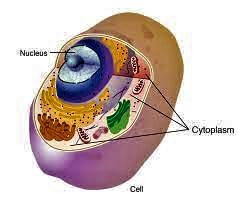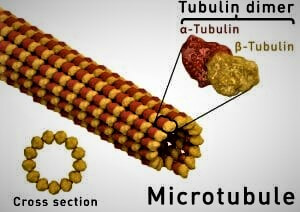Cytoplasm DefinitionThe complete fluid of the cell also includes the cytosol with filaments, proteins, ions and macromolecular structures suspended in the cytosol, referred to as cytoplasm in eukaryotic cells. Except for the nucleus, cytoplasm refers to the contents of the cell. Eukaryotes have complex systems for keeping the nuclear compartment separate from the cytoplasm. The jelly-like fluid that fills the cell and is surrounded by the cell membrane is known as cytoplasm. It comprises organelles like mitochondria, ribosomes, the endoplasmic reticulum, cytoskeletal fibres, and other structures. Cytoplasm is required for several biological operations, including metabolism, protein synthesis, and chemical transport throughout the cell. It also serves as a supporting medium for the cell's organelles to carry out their activities. Active transport is required for the formation of these subcellular structures as well as the maintenance of cytoplasmic homeostasis. Since prokaryotic cells lack a distinct nuclear membrane, the cytoplasm contains the cell's basic genetic material. These cells are typically smaller than eukaryotes and have a simpler internal cytoplasm architecture. 
Structure of CytoplasmCytoplasm is unusual because of is unlike any other fluid in the physical world; liquid substances that are well studied to understand diffusions and contain a few solutes in an aqueous medium and environment. The cytoplasm is a complex and hard to configure and crowded system containing a huge range of particles, from ions and small molecules. to proteins, as well as multiprotein complexes and organelles. These components are transferred around the cell based on the needs of the cell via a complex cytoskeleton and specialized motor proteins. The migration of such big particles alters the cytosol's physical characteristics. The cytoplasm's physical properties vary. Sometimes rapid diffusion occurs across the cell, causing the cytoplasm to resemble a colloidal solution. It looks to have the qualities of a gel-like or glass-like material at times. It is reported to have the qualities of both viscous and elastic materials, capable of deforming slowly under external force and recovering its previous shape with minimum energy loss. The cytoplasm near the plasma membrane is also 'stiffer,' whereas the portions in the interior resemble free-flowing liquids. These cytoplasmic alterations appear to rely on the cell's metabolic activities and serve a crucial role in carrying out certain tasks and shielding the cell from stress. The cytoplasm structure is divided into three parts.
Cytoskeleton and Motor ProteinsThe basic shapes of the cell are provided by its structure cytoskeleton, formed primarily by three types of polymers made- microtubules, actin filaments and intermediate filaments. Actin or microfilaments are 7 nm wide and consist of double-stranded F-actin polymers. These filaments are linked to various proteins that aid filament formation and anchor them near the plasma membrane. Its cytoplasmic position allows microfilaments to respond quickly to signal molecules from the external environment and induce cellular responses via signal transduction or chemotaxis. Myosin, an ATP-based motor protein, transports cargo and vesicles along the microfilament and participates in muscle contraction. Microfilaments are polymers of tubulin that form a hollow tube by the lateral assembly of Thirteen fibrils. Each protofilament is a polymer of tubulin molecules that alternate. A microtubule has an internal diameter of 12 nm and an outer surface of 24- nm. 
Organelles and Other Large Multiprotein ComplexesMost eukaryotic cells feature a variety of organelles that serve as specialized microenvironment compartments inside the cytoplasm. Lysosomes, for example, contain a variety of hydrolases in an acidic environment that is optimal for their enzymatic activity. These hydrolases are actively transported into the lysosome after being synthesized in the cytoplasm. Mitochondria, although having their genome, require several enzymes that are generated in the cytoplasm and then selectively transported into the organelle. Because of the physical gel-like structure of the cytoplasm and their attachment to the cytoskeleton, these organelles are put in precise regions. Ribosomes are huge RNA and protein complexes required to translate mRNA code into protein amino acid sequences. Proteasomes are massive molecular structures with a mass of 20,000 kilodaltons and a diameter of 15 nm. Cytoplasmic Inclusions and Dissolved SolutesA wide range of biochemical, from small forms of protein crystal to pigments, carbohydrates and fats; all the cells, like adipose etc., contain droplets of lipids in the triglyceride form. They are used to make cellular membranes and are a great energy source. Lipids may produce twice as many ATP molecules per gramme than carbs. Nevertheless, extracting this energy from triglycerides requires a lot of oxygen; thus, the cell also has glycogen reserves as cytoplasmic inclusions. They are used to form cell membranes and provide a lot of energy. Lipids may create twice as many ATP molecules per gramme as carbohydrates. The process of obtaining this energy from triglycerides, however, demands a lot of oxygen; thus, the cell also possesses glycogen stores as cytoplasmic inclusions. Functions of CytoplasmThe monomers that go on to form the cytoskeleton are also found in the cytoplasm. The cytoskeleton is essential for cells with particular shapes and is required for typical cell activity. For example, intermediate filaments, microtubules, and actin filaments are required in neurons with long axons to create a rigid framework for delivering the action potential to the subsequent cell. Along with designating specific sites for various organelles, the cytoplasm aids in establishing order inside the cell. For instance, the nucleus and centrosome are often located in the middle of the cell. Cytoplasm InheritanceThe chloroplast and mitochondria are two organelles that reside in the cytoplasm and have their genomes. These organelles comprise genes inherited outside the nucleus since they are inherited directly from the mother through the oocyte. These organelles respond to the demands of the cell and multiply independently of the nucleus. Hence, cytoplasmic or extranuclear inheritance creates a continuous genetic line that has not experienced mixing or recombination with the male parent.
Next TopicTransportation Definition
|
 For Videos Join Our Youtube Channel: Join Now
For Videos Join Our Youtube Channel: Join Now
Feedback
- Send your Feedback to [email protected]
Help Others, Please Share










